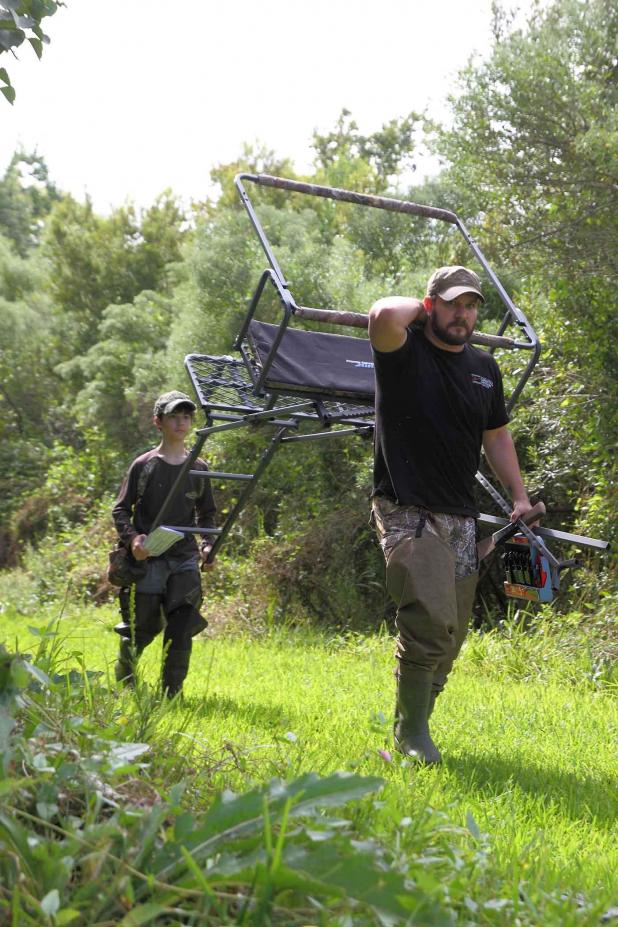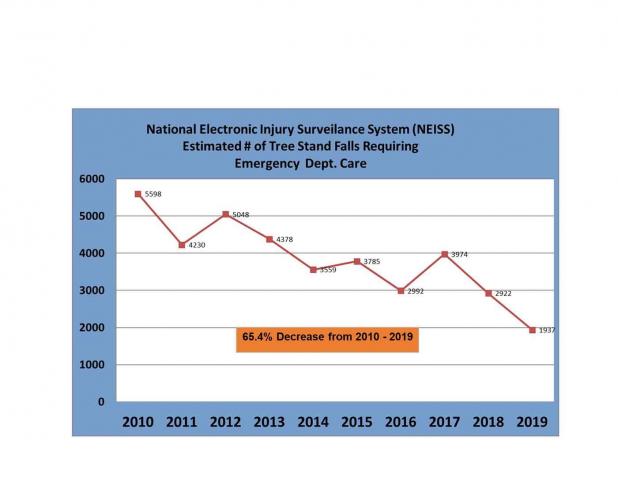
The Daily Review/John Flores
The author’s son and grandson carry a stand they put up prior to the deer season.

John Flores: Deer season is time to tend to safety in the stand
As regular cool fronts slowly make their way into Louisiana this month and next, deer hunters will increasingly take to the woods and marshes around the state. Most of them in some fashion or another will hunt from an elevated deer stand as a way to improve their visibility when overlooking a field or food plot. Elevation also helps to minimize and displace scent.
Essentially, deer live and die by their nose. And, mark my words, they can smell a honeybun 100 yards away under the right conditions.
Nevertheless, deer stands come in all shapes and sizes from large elaborate box-type, known to many as “shooting houses,” to thrown together, cheaply made, ladder-type lean-to perches secured to trees. Because of low cost and quick deployment, hang-on and lean-to stands make up the vast majority of tree stands in the woods today.
The question is, how safe are these deer stands and the hunters who are using them?
Statistics seem to vary year to year and state to state when it comes to deer stand-related accidents and injuries. Even the latest data provided online by the CDC dates back to 1989. Nonetheless, estimates nationally appear to indicate that there is somewhere between 2,000 to 4,000 injuries from deer stand accidents that occur each year.
Glen Mayhew, President of the Tree Stand Safety Awareness Foundation, says the foundation doesn’t keep data on the kinds of injuries related to stand types. However, they do maintain statistics on the percentage of injuries associated with “types” of stands.
TSSA 2018-19 data revealed hang-on deer stands accounted for 39% of the injuries that occurred, ladder stands 22%, climbing stands 15%, homemade stands 19%, and others such as tripods and shooting houses 5%.
Mayhew said, “We are making great progress in reducing the number of estimated falls that occur each year that require emergency department care. TSSA had set a goal to reduce that number by 50 percent by 2023. Through the combined efforts of many throughout the hunting and outdoors industry, we surpassed that goal by the end of 2019. We have seen a decrease of 65 percent from the baseline data available in 2010.”
Jerry Wydner, owner of Hunter Safety System located in Danville, Alabama, says one of the most common mistakes hunters make when it comes to deer stand safety is not wearing a safety harness.
Wydner, who has over 500 letters on his desk from hunters who have shared their life-altering experience wearing HSS equipment said, “Even though more and more hunters are wearing a harness today, not wearing a full-body harness is still the number one cause of hunting related accidents.
“According to studies by L.J. Smith, professional tree stand accident investigators,” Wydner continued, “86% of tree stand falls occur when the hunter is ‘not’ in the tree stand. For this reason a hunter must stay attached to the tree from the moment he leaves the ground and stay attached until both feet return to the ground. The best and easiest way to do this is with a lifeline.”
Unlike sectors of industry such as construction, fabrication and manufacturing that are governed by OSHA standards like 29 CFR 1910.23, .28, and .29 that regulate and deal with working from elevated surfaces, Wydner points out there is no government or industry mandate that requires hunters to wear a safety harness.
However, there are manufacturing standards developed by the Tree Stand Manufacturers Association (TMA) that Mayhew mentions that do require a full-body harness to come with each deer stand sold.
Having personal experience utilizing the harnesses that come in the box with metal lean-to stands that I’ve purchased in the past, let’s just say they work when used properly and will do when nothing else is available. Particularly, since the latest data shows 83% of fall victims were not wearing a harness.
Typically, hunters enter and leave the woods under the cover of darkness. In the dark they negotiate trails and are usually carrying some sort of bulky gear bag, along with a bow or firearm. Wearing a strap-type harness that is prone to getting tangled in underbrush and difficult to connect to a tree is a recipe for disaster.
Wydner said, “When we started our company in 2001, our goal was to change the minds of hunters who refused to wear safety equipment. We knew the reasons why hunters were not wearing their harnesses at the time. Equipment was terribly confusing and very unfriendly to the hunter. We make our equipment in such a fashion as to take away the excuses hunters will use to not wear a harness.”
Other common mistakes concerning deer stand safety that both Mayhew and Wydner mention are leaving stands in place season after season, not replacing the straps on trees annually, not doing the preventive maintenance that may be needed, and not taking into consideration natural tree growth.
All of these mistakes are easily corrected by being more proactive prior to each season.
For more information on Hunter Safety System harnesses and lifelines go to www.huntersafetysystem.com or call 256-773-7732. The TSSA Foundation provides YouTube videos on Tree Stand Safety that are both helpful and educational. Simply go to YouTube and type TSSA Tree Stand Climbing Safety.
Wydner said, “It’s very humbling, yet motivating, to read these letters and realize we had something to do with saving a life. Saving lives is what we do.”
Graph measuring the decline in emergency room injuries from deer stand accidents in the last decade.
